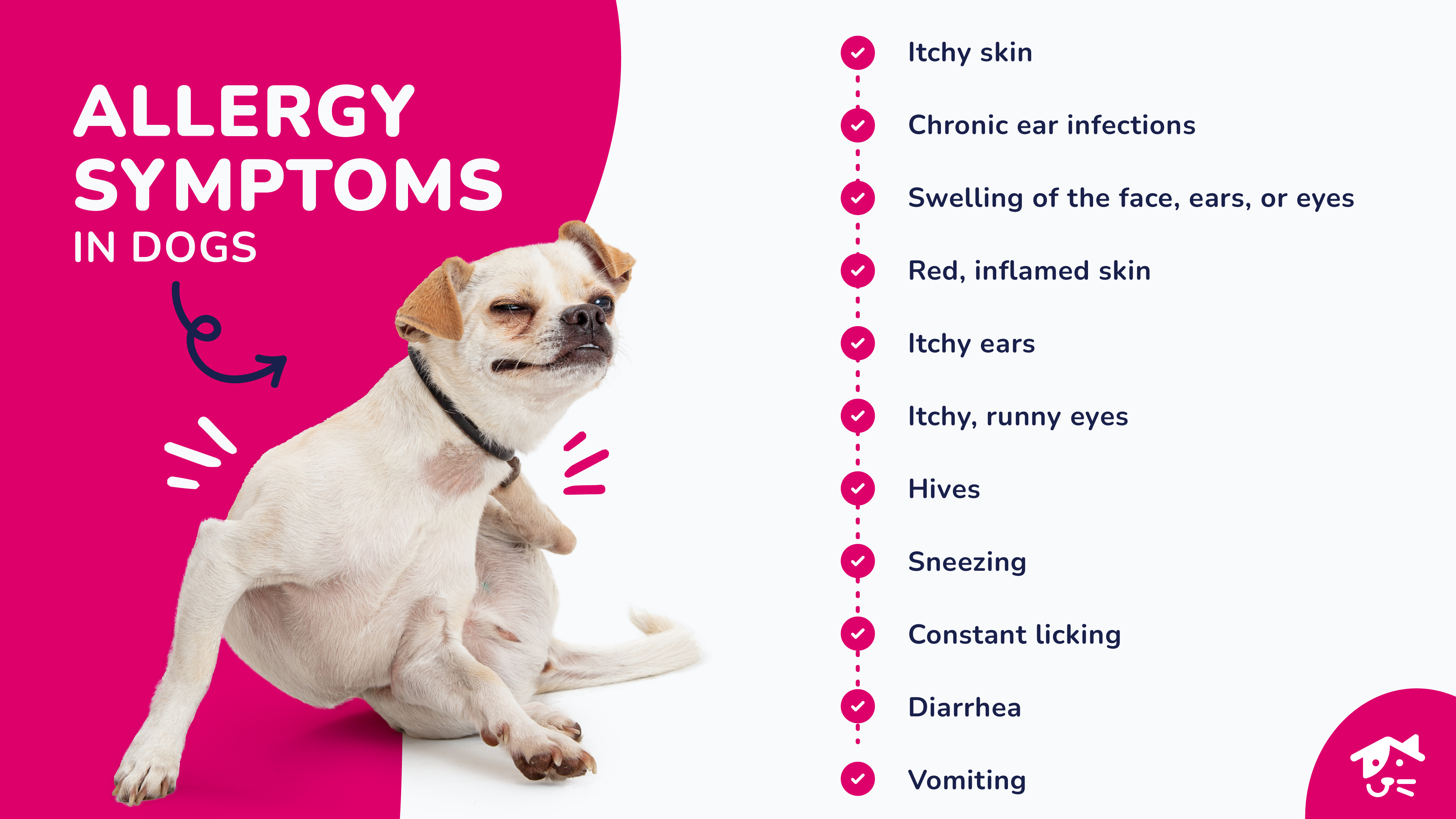Allergies in Dogs: Types, Symptoms and Treatment Options

Table of Contents
Like humans, dogs can develop allergies when their immune system overreacts to substances in their environment, called allergens.
These allergens can be things like pollen or dust mites, or even ingredients in their food, such as chicken or beef. This overreaction triggers inflammation and irritation in the skin, which can lead to secondary infections if left untreated.
As a veterinarian that treats many dogs with allergy symptoms, I'll cover the different types of dog allergies, common symptoms, and treatment options to help your furry friend find relief from discomfort caused by allergic reactions.
Key Takeaways
-
Many dogs deal with allergies from pollen or food ingredients
-
Common symptoms include itchy skin, watery eyes, and sneezing.
-
Consulting a vet for an allergy consultation is essential, leading to relief through treatments like antihistamines or specialized diets.
Types of Dog Allergies
Allergies come in different forms. Let's explore the various types of dog allergies, including those that cause itchy skin, sensitivities to environmental triggers, and reactions to certain foods.
Skin Allergies
-
Allergic dermatitis: Also known as atopy, allergic dermatitis typically occurs secondary to exposure to environmental allergens, causing widespread skin and ear inflammation.
-
Contact allergy: Dogs can develop an allergic reaction to something they come into contact with, such as cleaning products, shampoos, certain fabrics, and topical medications. This can lead to a localized or full-body reaction.
Does Your Pet Have Skin Allergies?
1. How frequently does your pet seem itchy?
2. Where does your pet scratch the most?
3. Which season is your pet’s symptoms the most noticeable?
4. How often does your pet seem uncomfortable?
5. Can you see any of the following symptoms on your pet’s skin?
6. Is your pet experiencing any of the following symptoms?
View Results
Environmental Allergies
-
Flea allergies: One of the most common causes of allergies in dogs is fleas, leading to severe itching and scratching.
-
Mold: A type of fungus that thrives in various environments indoors and outdoors. Microscopic mold spores within the environment trigger an allergic response. Mold spores can be found in the air, water, soil, and on surfaces.
-
Pollen: Produced from plants for reproduction purposes, pollen can travel for miles on a gust of wind. It can be microscopic or visible in the air or covering outdoor items. Pollen allergens are typically higher in spring and fall when levels of airborne allergens are elevated.
-
Airborne allergens: Particulate matter, industrial emissions, and vehicle exhaust can exacerbate allergy symptoms. Poor indoor air quality can also contribute to allergies.
-
Dust Mites: These microscopic arthropods live indoors, particularly in bedding, carpets, and upholstered furniture.
-
Dander: Just like humans can be allergic to dog and cat dander, dogs can be allergic to other pet dander or human dander.
Food Allergies
-
Dairy: Milk, cheese, ice cream, and yogurt contain proteins (casein & whey) that trigger reactions, causing gastrointestinal and skin/ear reactions.
-
Beef: A common food allergen in dogs, causing gastrointestinal upset, itchy skin, skin inflammation, and ear & skin infections.
-
Chicken: Another common food allergen with effects similar to beef.
-
Chicken eggs: Like chicken, they can cause GI upset, itchy skin, skin inflammation, and ear & skin infections.
-
Soy: Soybeans and soy products can cause allergies, leading to GI upset, itchy skin, skin inflammation, and ear & skin infections.
-
Wheat gluten: Wheat and other grains containing gluten can cause allergies, resulting in GI upset, itchy skin, inflammation, and ear & skin infections.
-
Fish: Salmon and tuna are examples of fish that could trigger an allergic reaction, with reactions similar to beef and chicken.
Common Allergy Symptoms in Dogs

Itchy skin isn't the only clue! Now that you're familiar with the various types of allergies, let's outline the most common symptoms to watch out for in your dog.
-
Itchiness: Occurs as a result of exposure to an allergen, triggering an immune response that releases histamine and other inflammatory mediators that cause itchiness.
-
Hives: Or urticaria are raised, itchy bumps triggered by allergens. They are usually red & inflamed and can vary in size and shape.
-
Swelling of the face, ears, lips, eyelids, or earflaps: Also known as angioedema. It is triggered by the release of histamine & other inflammatory mediators, resulting in swelling and inflammation of deeper layers of skin and tissues. Common triggers include food products, insect bites/stings, and medications.
-
Red, inflamed skin: Triggered by histamine & other inflammatory mediators released in the skin, causing itching & irritation.
-
Diarrhea: Often secondary to a food allergy, but other allergens can induce it as well. It causes inflammation of the GI tract, preventing normal digestion & discomfort. This can lead to increased muscle contraction or peristalsis, resulting in rapid movement of food & waste through the GI tract and increased fluid secretions into the GI tract, leading to watery diarrhea.
-
Vomiting: Similar to diarrhea, inflammation can lead to nausea.
-
Sneezing: When allergens are inhaled, they cause an overreaction of the immune system of the respiratory mucosa (lining of nose, throat, respiratory tract), leading to the release of histamine & other inflammatory mediators. This causes inflammation & irritation, and sneezing is the body's response to remove the irritant out of the nasal passages.
-
Itchy ears: Similar to itchy skin, the release of histamine & inflammatory mediators causes the skin of the ear to become itchy.
-
Chronic ear infections: These can develop secondary to allergens. Long exposure to allergens creates inflammation of the ear flaps and canals. The overreaction of the immune system & chronic inflammation make the ears more susceptible to bacterial & yeast infections.
-
Itchy, runny eyes: When exposed to an allergen such as pollen or mold, an inflammatory response occurs within the conjunctiva of the eyes, causing itchiness & tearing. Tearing is a protective mechanism used to flush allergens out of the eyes. The more itching occurs, the more swelling & tearing develops, leading to red, irritated eyes.
-
Constant licking: Licking is similar to itchiness. The release of histamine & other inflammatory mediators causes irritation of the skin, which can entice a dog to lick certain areas, especially the paws and belly.
Signs of Allergic Reactions in Canines
If you notice the signs below, it is best to seek veterinary care immediately:
-
Canine urticaria/hives
-
Edema of the face or throat
-
Anaphylactic shock: Also known as Anaphylaxis, this is a severe and potentially life-threatening allergic reaction. It usually occurs rapidly after exposure to an allergen and requires immediate intervention. The immune system triggers an exaggerated and systemic immune response, with symptoms affecting multiple organ systems:
-
Difficulty breathing, coughing, swelling of throat or tongue
-
Hypotension (low blood pressure), fainting, heart arrhythmias
-
Nausea, vomiting, diarrhea, abdominal pain
What to do if Your Dog is Having an Allergic Reaction
Knowing what to do if your dog experiences an allergic reaction can make a big difference. Here are some key steps to take.
-
If your dog is experiencing an allergic reaction that is causing hives, facial swelling, or anaphylaxis, seek veterinary care immediately.
-
Skin allergies such as itchy skin, irritated eyes, & sneezing may improve with antihistamines such as Benadryl or Zyrtec. Still, it is best if you follow the guidance of a veterinarian.
-
Dogs with recurring chronic allergy symptoms often require a therapeutic plan developed by a veterinarian to reduce symptoms & prevent recurrence.
Diagnosing Allergies in Dogs
Symptoms are just the beginning. Explore how veterinarians diagnose dog allergies through various tests and trials, pinpointing the exact cause of your pet's discomfort.
-
Symptoms following exposure to an allergen can help aid in the diagnosis of an allergen.
-
Allergy testing either via blood test or intradermal skin test.
-
Food trial or elimination trial is used to diagnose diet allergies. This is achieved by feeding a hypoallergenic diet only for 8 to 10 weeks, then slowly introducing different protein sources one at a time to evaluate the body's response.
Dog Allergy Treatment Options
When it comes to managing your dog's allergies, various treatment avenues are available. They are designed to alleviate your furry friend's discomfort effectively.
-
Antihistamines: These medications work by blocking the effects of histamine.
-
Apoquel: This highly effective prescription controls allergies by inhibiting enzymes involved in the inflammatory process, reducing itchiness and inflammation.
-
Cytopoint: An injectable therapy administered every 4 to 8 weeks, providing long-lasting relief typically within 1 to 2 days after administration.
-
Hypoallergenic diets: Specifically designed with proteins that have been broken down several times so they cannot trigger a reaction, or they may incorporate novel protein sources such as rabbit, which is typically low in allergens.
-
Avoidance of the allergen: If you identify the allergen, avoiding it (if possible) is the most effective approach.
-
Corticosteroids or steroids: These medications provide rapid relief of inflammation and break the itch cycle. However, long-term use can have negative side effects.
-
Allergen immunotherapy: This treatment involves gradually administering increasing doses of allergens over time to desensitize the immune system and reduce allergic reactions.
-
Flea preventatives: Monthly flea preventatives can help reduce the onset of allergies caused by fleas.
Allergy Prevention and Home Remedies
Learn how to minimize allergen exposure and provide relief for your furry friend right in your own home.
-
Minimize exposure to outdoor allergens when possible
-
Use air purifiers or Hepa filters to remove airborne allergens in the home
-
Reduce indoor humidity levels to prevent mold formation
-
Vacuuming and cleaning regularly to remove allergens in the environment
-
Use hypoallergenic bedding & detergents
-
Regular bathing & grooming to remove allergens from the coat & skin
-
Monitor your dog when introducing a new diet or treat
Conclusion
Many dogs suffer from allergies triggered by various factors, including environmental allergens and ingredients in their food. Whether your pet is experiencing mild symptoms or severe reactions, BetterVet offers home visits tailored to your pet's needs.
Contact us to schedule an allergy and dermatologic exam to help your furry friend find comfort.
Does Your Pet Have Itchy Paws or Flaky Skin?
Our veterinarians can bring relief. Schedule a visit for allergy testing in the comfort of your home.
Frequently Asked Questions
What can I give my dog for allergies?
You can give your dog Benadryl at 1mg per pound, but it's best to consult your vet first. Bathing with hypoallergenic shampoos and providing low-allergen diets and treats can also help. For a comprehensive long-term plan, consult your veterinarian for personalized recommendations, which may include shampoos, dietary adjustments, and allergy medications.
What is the most common food allergy in dogs?
The most common food allergies in dogs are to chicken and beef.
How do I figure out what my dog is allergic to?
To identify your dog’s allergies, work with your veterinarian to determine what your dog is allergic to. Using allergy testing and diet trials, your veterinarian can narrow down all the possible causes of allergies.
What are the top 3 things dogs are allergic to?
The top three things dogs are allergic to are fleas, environmental allergens such as pollen, grasses, and weeds, and certain food ingredients like chicken, beef, and fish.
What are the types of allergy shots for dogs?
The types of allergy shots for dogs include allergen immunotherapy and Cytopoint, a monoclonal antibody that neutralizes part of the inflammatory pathway that triggers allergy symptoms
Sources:
-
Carlotti, D.N., Remy, I. and Prost, C., 1990. Food allergy in dogs and cats. A review and report of 43 cases. Veterinary Dermatology, 1(2), pp.55-62.
-
Virtanen, T., 2018. Immunotherapy for pet allergies. Human Vaccines & Immunotherapeutics, 14(4), pp.807-814.
-
Curin, M., Reininger, R., Swoboda, I., Focke, M., Valenta, R. and Spitzauer, S., 2011. Skin prick test extracts for dog allergy diagnosis show considerable variations regarding the content of major and minor dog allergens. International archives of allergy and immunology, 154(3), pp.258-263.






